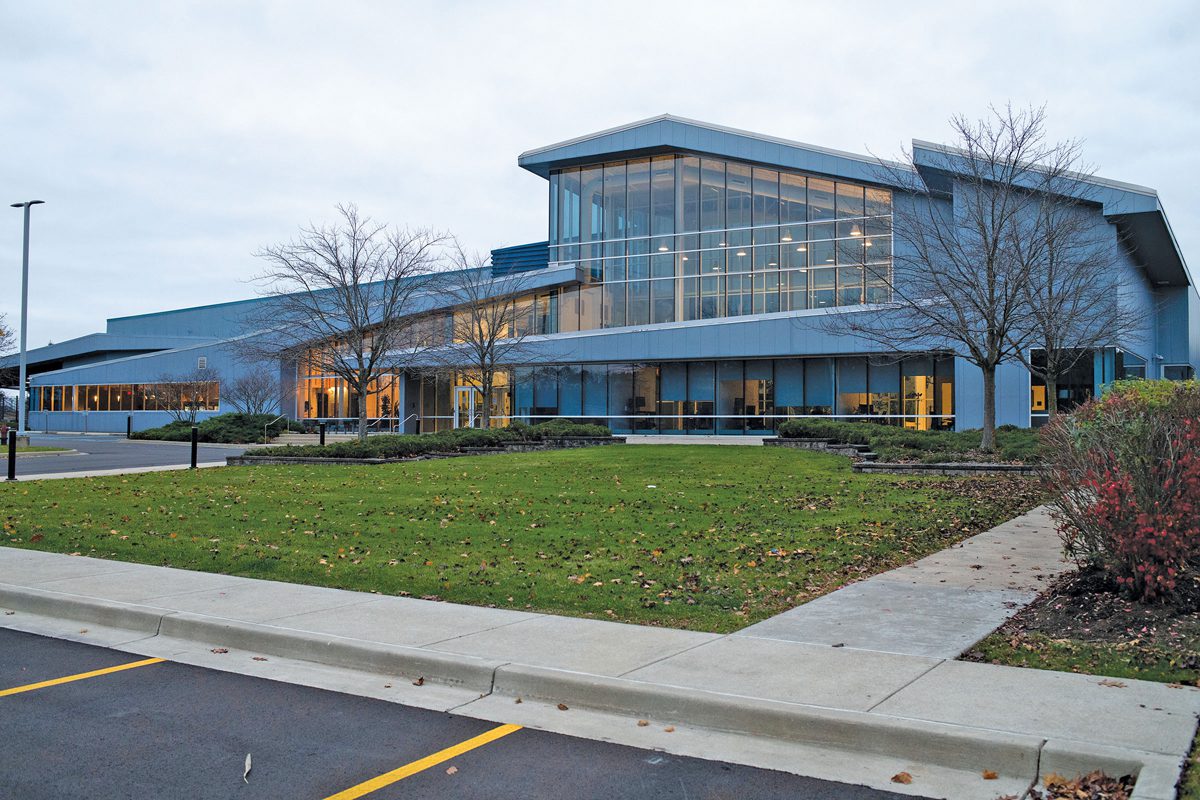
The Ann Arbor News opened a massive printing plant in Pittsfield in 2001, only to close it in 2016 as ad sales plummeted. Google now rents the building to scan books, the News is printed in Cleveland, and its parent company is urging subscribers to trade their newpapers for emailed facsimiles. | Photo by Mark Bialek
Advance Publications, owners of the Ann Arbor News and seven sister MLive papers, announced in October that it will shut down the Jersey Journal at the end of January, while also eliminating print editions of its flagship Star-Ledger and two other papers in New Jersey.
Following the digital transition of four Advance-owned papers in Alabama and Mississippi in 2023, this move raises the possibility that print editions of the News and the rest of the MLive group could be next.
Fifteen years ago, the News was America’s first sizable daily to slash its print edition from seven days a week to two. It was replaced by a new entity called AnnArbor.com. The name was used both in print and online, reflecting the hopes of Advance’s owners, the Newhouse family, to build an internet-first business that cost less to produce while engaging readers as commentators and contributors. “We felt that it was our best chance to have a model that would scale well into the future,” Steve Newhouse told the Observer’s Vickie Elmer in 2009.
“In many ways,” says Tonda Rush, legal counsel to the National Newspaper Association, “Advance was way out in front in developing online and starting a digital operation and worked out all the challenges while the rest of the industry was trying to figure out a strategy.”
Everyone’s strategy turned out to be cutting costs: slashing hundreds of staff positions, selling off office buildings, and shutting down printing plants. In 2008, American newspapers had 71,000 editorial employees. By 2020 that number had dropped to 31,000.
But in Ann Arbor, the new online model was a failure. Most of the community contributions weren’t paid, and soon stopped posting. Online comments degenerated into scornful political exchanges. In 2013, Advance restored the Ann Arbor News name to the print paper, dropped the dedicated website, and again directed online readers to the statewide MLive.com.
Related: RIP AnnArborcom
It turned out that online advertising alone couldn’t support the in-depth reporting the News and other print papers once provided. Elisa Shearer, Pew Research Center’s senior researcher for news and information, points out that in 2005 ad revenue of $49 billion was nearly five times circulation revenue of $11 billion. By 2022, circulation revenue edged up to $12 billion—but ad revenue fell below $10 billion.
In recent years, even the biggest online national news sites have been laying off workers and looking for additional sources of revenue. Vice Media, once valued at almost $6 billion, went bankrupt in May. In September, it relaunched the print magazine it had closed five years ago.
That may be why newspapers ranging from the Los Angeles Times to the Toledo Blade continue to promote print subscriptions. Instead, MLive has been deluging print readers with ads urging them to save 40 percent by switching to online-only subscriptions.
Advance isn’t talking about its strategy, but in Ann Arbor, a print subscriber paid $463 last year for two papers a week. A Muskegon reader paid $797 for three. Yet both are being deluged with offers to “Save up to 40%” by going digital—and promising to enter them in a $500 Visa gift card drawing every time they visited the website.
According to the Michigan Press Association, 8,100 people subscribed to the Ann Arbor News two days a week in 2022 and 14,000 on Sunday. Based just on advertised introductory rates, those should have brought in close to $6 million a year in revenue. But to earn it, the company had to print more than 1.5 million papers and deliver them to 22,000 subscribers. Statewide, print subscription revenue may have exceeded $50 million—at the cost of printing more than 14 million papers and delivering them to more than 200,000 customers.
When the Muskegon reader asked about the digital discount, they were quoted a daily price of $10.99, or about $571 a year—a savings of 29 percent, not 40. But MLive also offers an online-only subscription for $115 a year. A rep explains that it only gets readers past the website’s paywall. The higher price includes a daily “digital paper”—an emailed PDF file.
Even if every MLive print subscriber went digital at the higher rate, its subscription revenue would fall by 29 percent. If they only want to get past the paywall, it would drop 70 percent. Yet Advance seems to have concluded that eliminating printing and delivery costs will more than compensate.
For readers, the question is whether any of the money saved will go into funding more local journalism. What’s happening elsewhere is not encouraging.
In New Jersey, the planned closure of the Jersey Journal has not led to a hiring spree of reporters: On a single December day, fifteen of sixteen stories appearing on its web edition had the same byline.
The Ann Arbor News continues to report U-M and local sports, and Ryan Stanton provides excellent government coverage. But on Thursdays it is difficult to find more than a handful of local stories in the print edition, while ads tout “exclusive” content available only online—the New York Times Book Review, additional sports coverage, some puzzles, and TV “highlights.”
Even much of what appears in the Sunday print edition is duplicated across the seven sister MLive papers. A relatively small amount of Ann Arbor news is surrounded by identical sections appearing in Grand Rapids, Saginaw, and other cities. Beat reporting is hard to do when a handful of reporters are juggling assignments ranging from a restaurant opening to a car crash.
Pew Research reports that nationally the number one source of local news is friends, family, and neighbors—at a breathtaking 73 percent. Newspapers are in seventh place, with 33 percent—behind TV, radio, online forums (Facebook and NextDoor), local organizations, and government agencies and officials. Although there are no data for the Ann Arbor market, in Grand Rapids, according to Pew, just 25 percent of residents get their local news primarily from newspapers, compared to 42 percent from TV. (Eighteen percent turn to radio, and 12 percent to online forums.)
Expanding newspapers’ audience is challenging, says Pew’s Shearer, because readers say they “can find plenty of local news free.” Unfortunately, much of their original content can be and is shared directly and indirectly online, including on Reddit—which is partially owned by Advance, alongside other properties like the New Yorker.
Rick Edmonds, a veteran media business analyst at the Poynter Institute, adds that “many print subscribers are not excited about navigating digital replica editions” like the ones emailed daily to MLive subscribers.
“People used to spend a lot of time with their paper,” Edmonds says. “Now they patch things together from different sources.”
MLive now has a single publisher for the entire state, John Hiner. His only public statement on the papers’ future in print was in January 2023, when he wrote that the company was not planning to eliminate it “at this time.”
In a December email, Hiner confirms that the company still has an Ann Arbor office at the corner of Huron and Ashley. Asked whether MLive will follow the other Advance papers in exiting print, he chose not to comment.
—
Roger Rapoport (rogerrapoport.com) is the author of Searching for Patty Hearst and producer of the feature film Old Heart (oldheartmovie.com), out in May.




